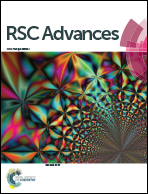A 4-tert-butylcalix[4]arene tetrahydroxamate podand based on the 1-oxypiperidine-2-one (1,2-PIPO−) chelate. Self-assembly into a supramolecular ionophore driven by coordination of tetravalent zirconium or hafnium(iv)†
Abstract
An octadentate tetrahydroxamic calix[4]arene podand incorporating 1-hydroxypiperidine-2-one (1,2-PIPOH) binding units has been designed as a specific chelator for tetravalent metal cations like Zr4+ or Hf4+. This receptor, which can be considered as the first ever abiotic ligand possessing only cyclic six-membered hydroxamate groups, has been synthesized and characterized in its tetraprotonated form (1H4). Contrary to expectation, however, this new chelator did not form a 1 : 1 complex upon reaction with M(acac)4 (M = Zr and Hf; acac = acetylacetonate), but rather self-assembled into a dimeric species of 2 : 2 stoichiometry. The latter could be characterized in solution by mass spectrometry and NMR spectroscopy as its monopotassium adduct ([M2K(1)2]+), pointing to the ionophoric character of the M2(1)2 complex.
![Graphical abstract: A 4-tert-butylcalix[4]arene tetrahydroxamate podand based on the 1-oxypiperidine-2-one (1,2-PIPO−) chelate. Self-assembly into a supramolecular ionophore driven by coordination of tetravalent zirconium or hafnium(iv)](/en/Image/Get?imageInfo.ImageType=GA&imageInfo.ImageIdentifier.ManuscriptID=C4RA00977K&imageInfo.ImageIdentifier.Year=2014)
- This article is part of the themed collection: Supramolecular chemistry: self-assembly and molecular recognition

 Please wait while we load your content...
Please wait while we load your content...